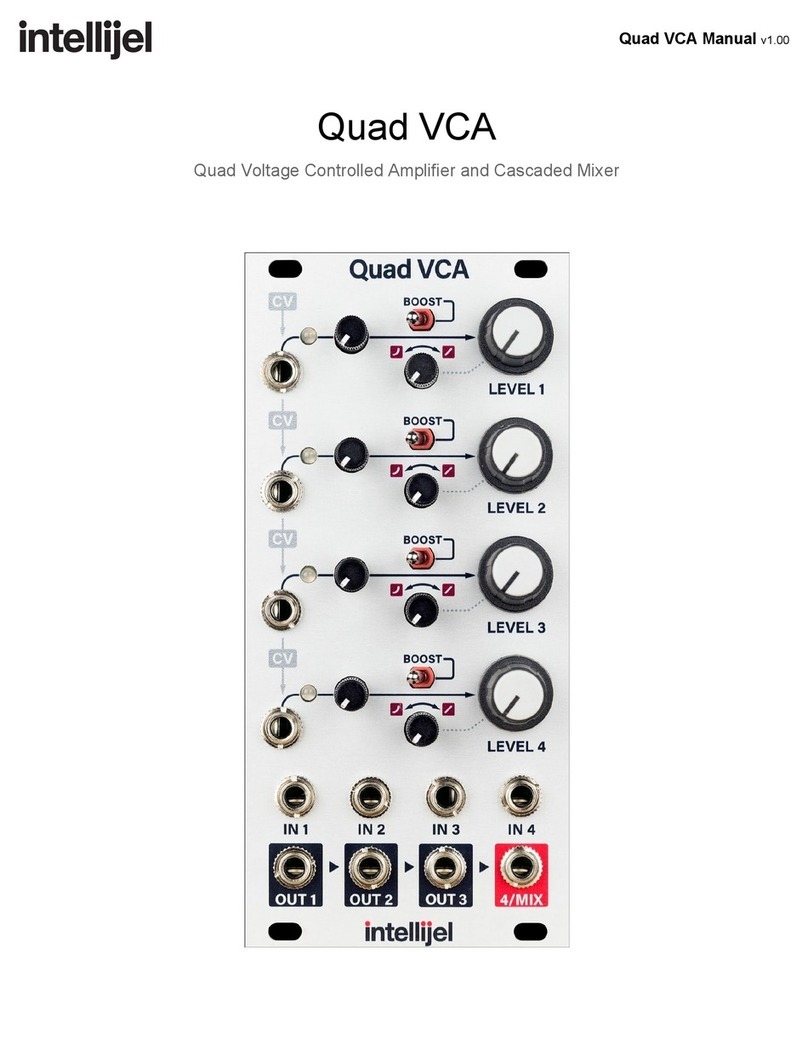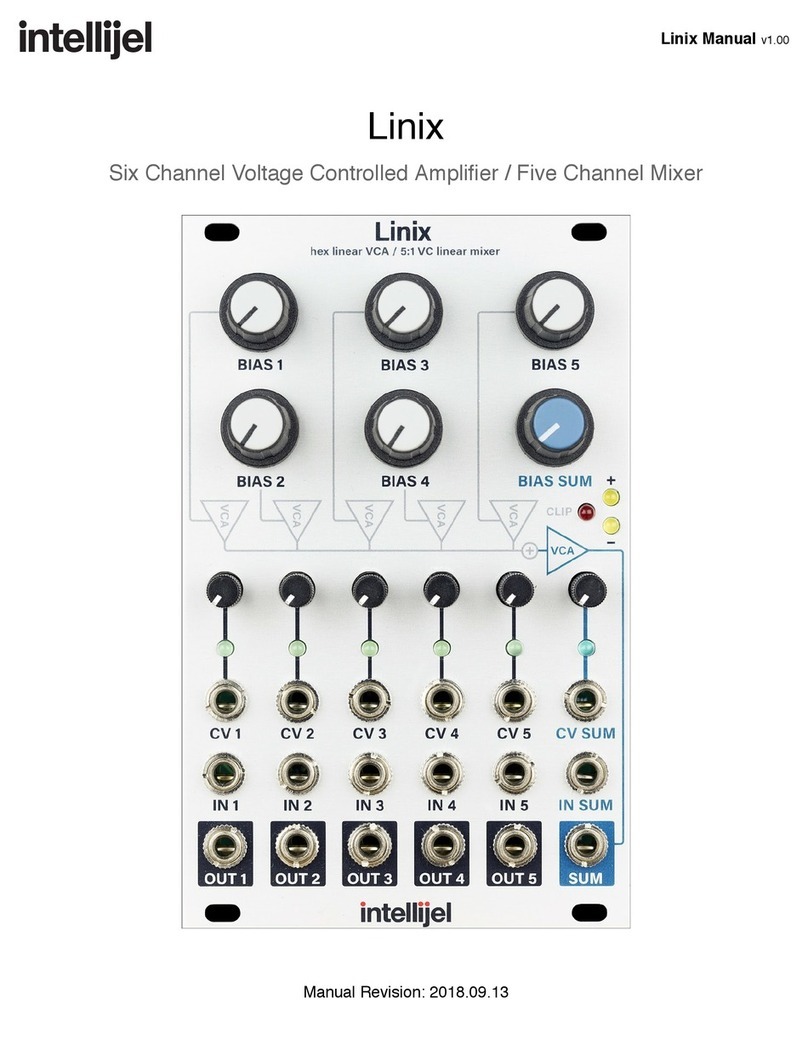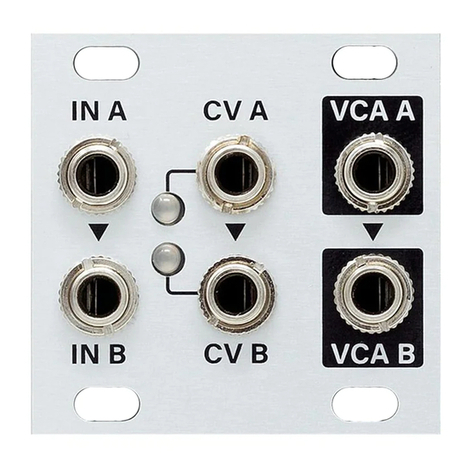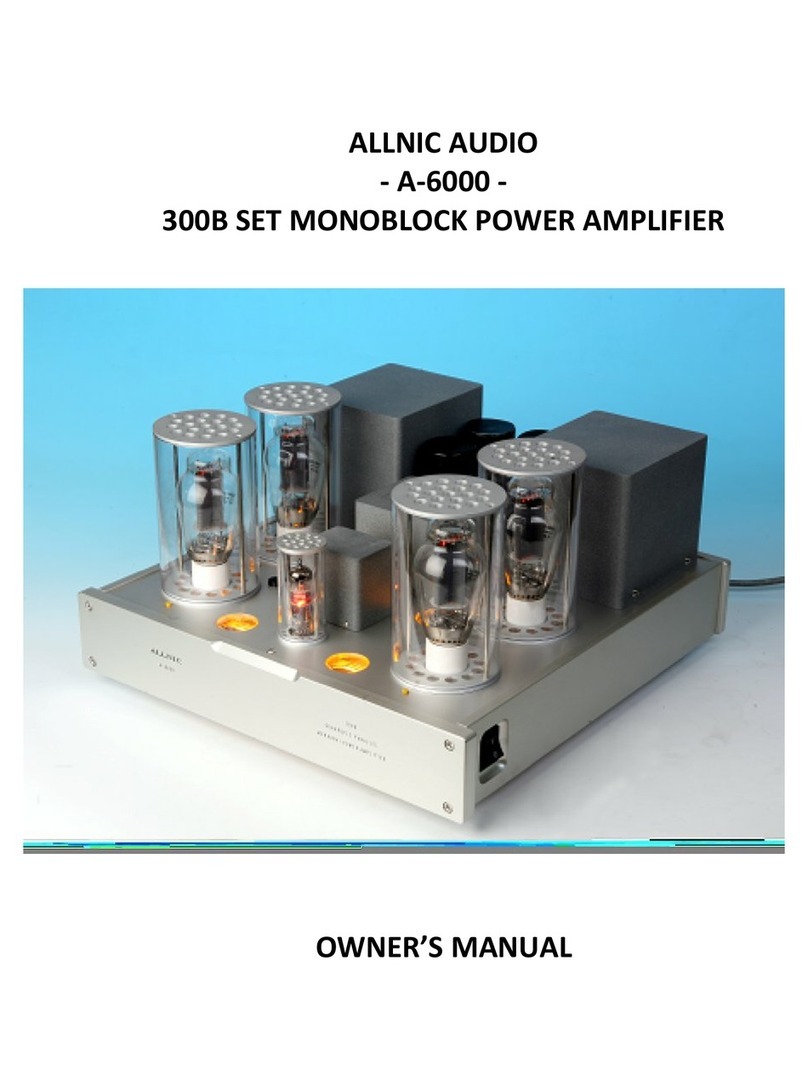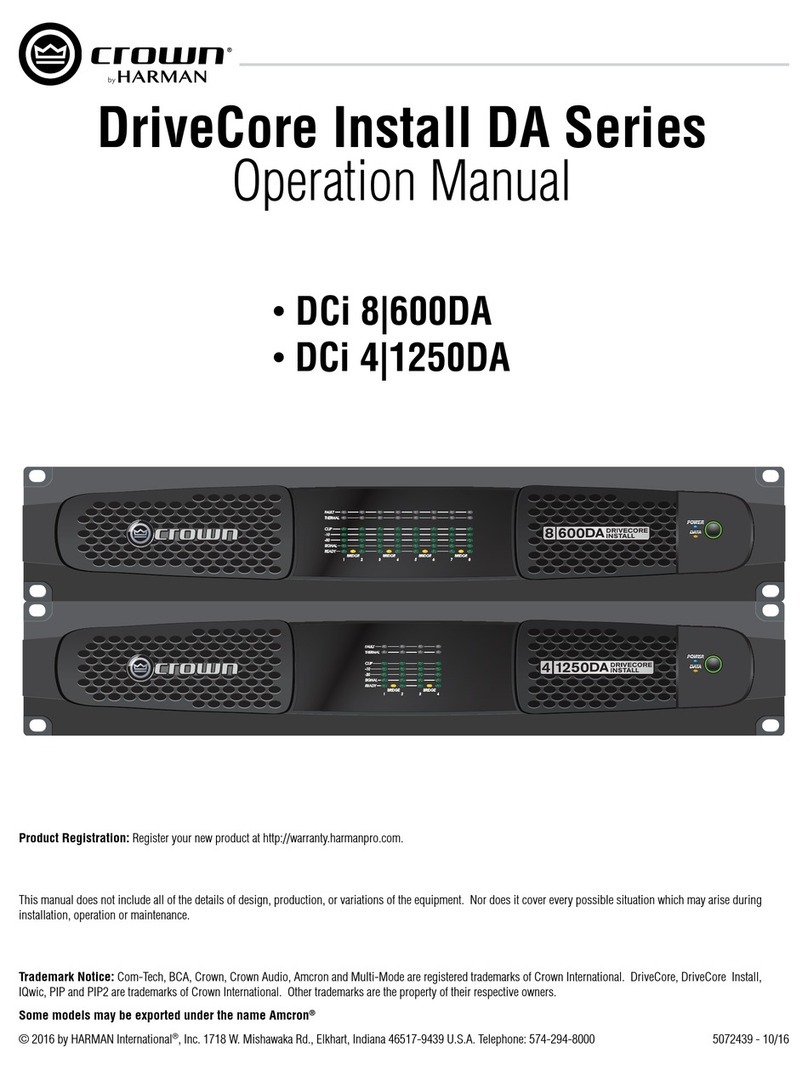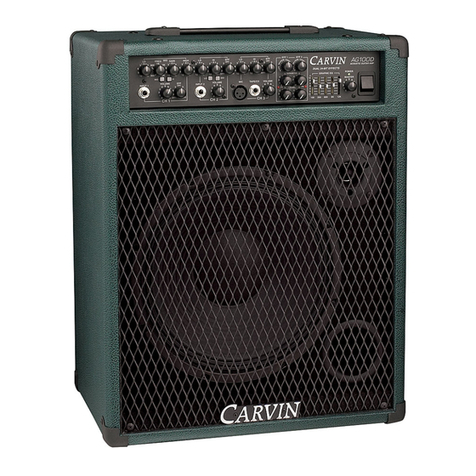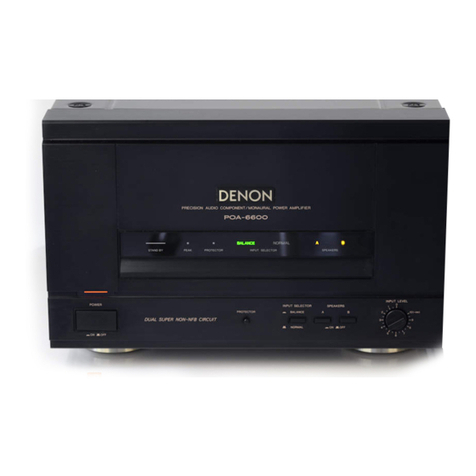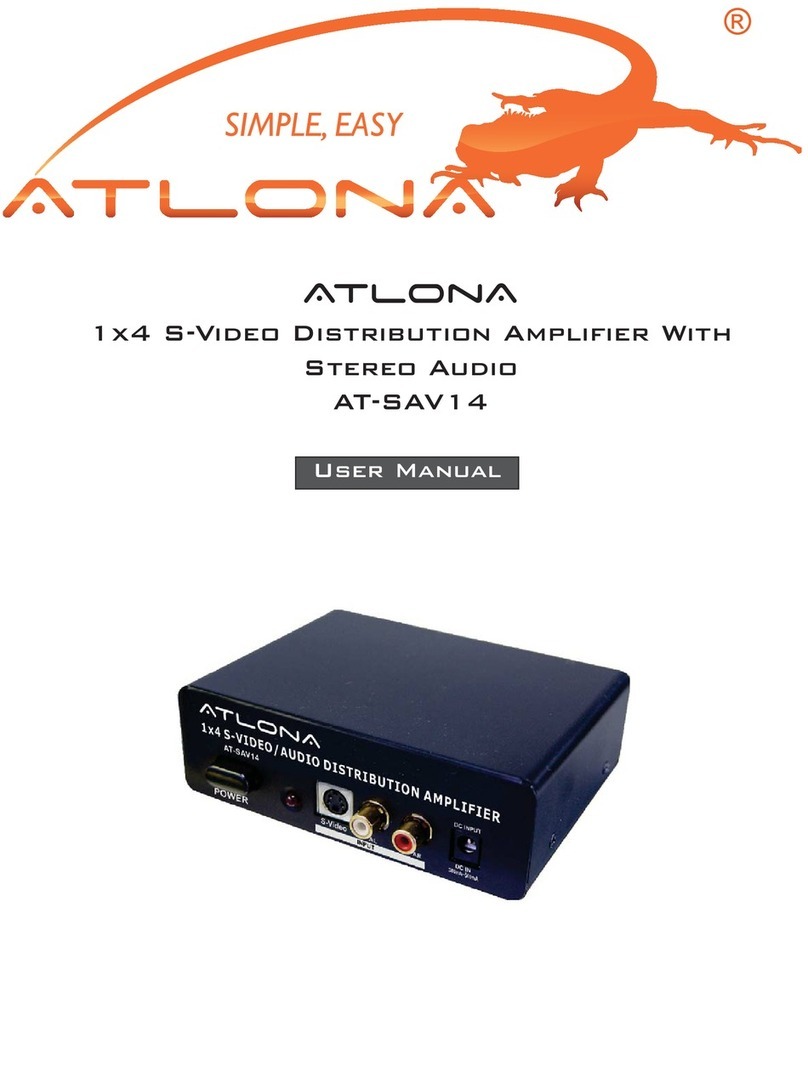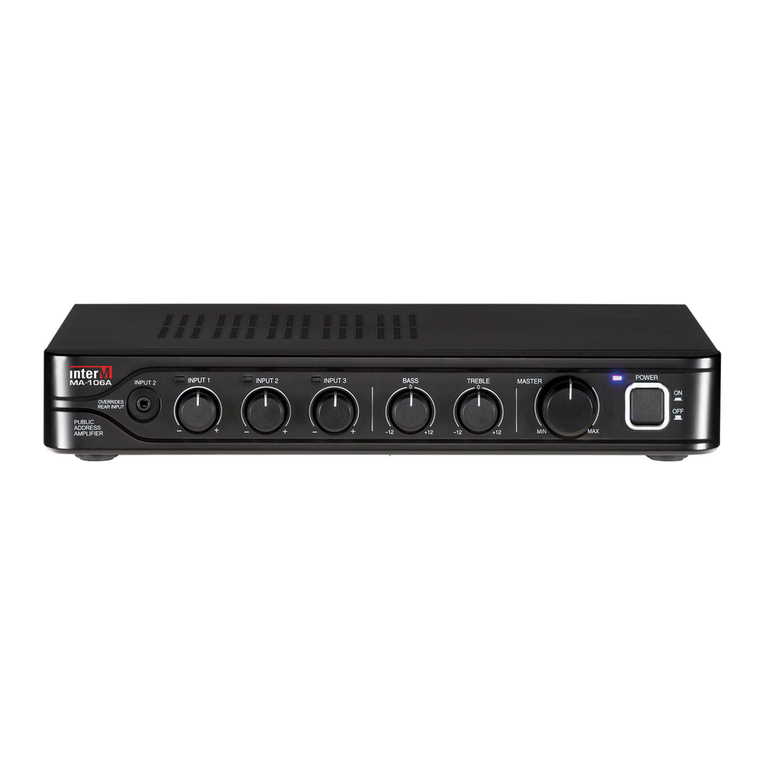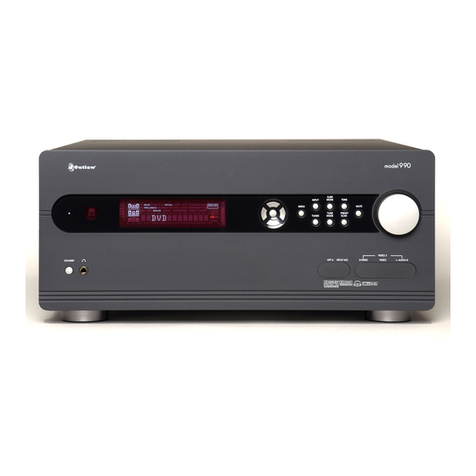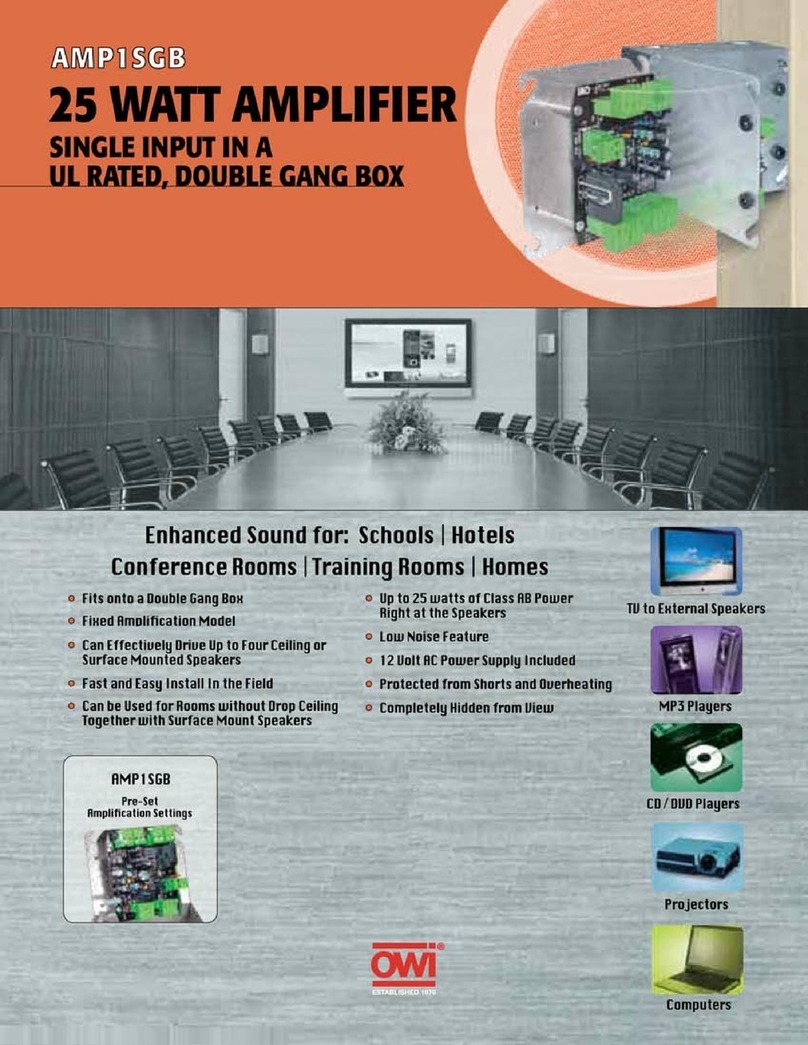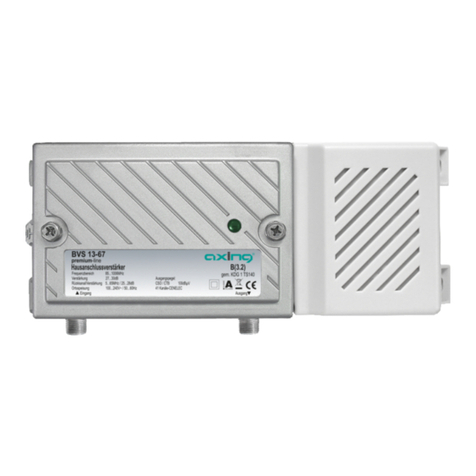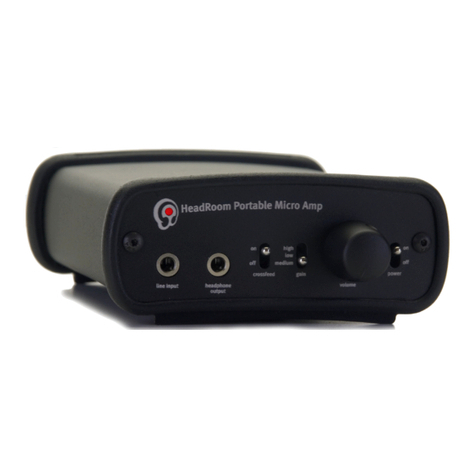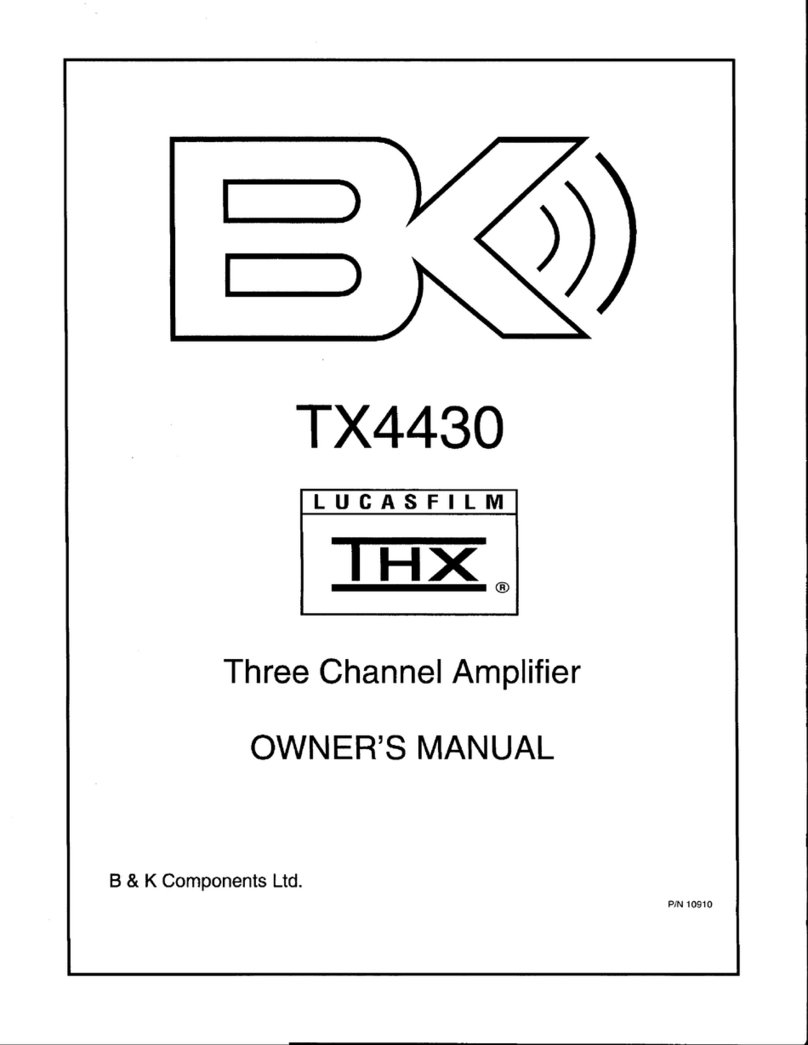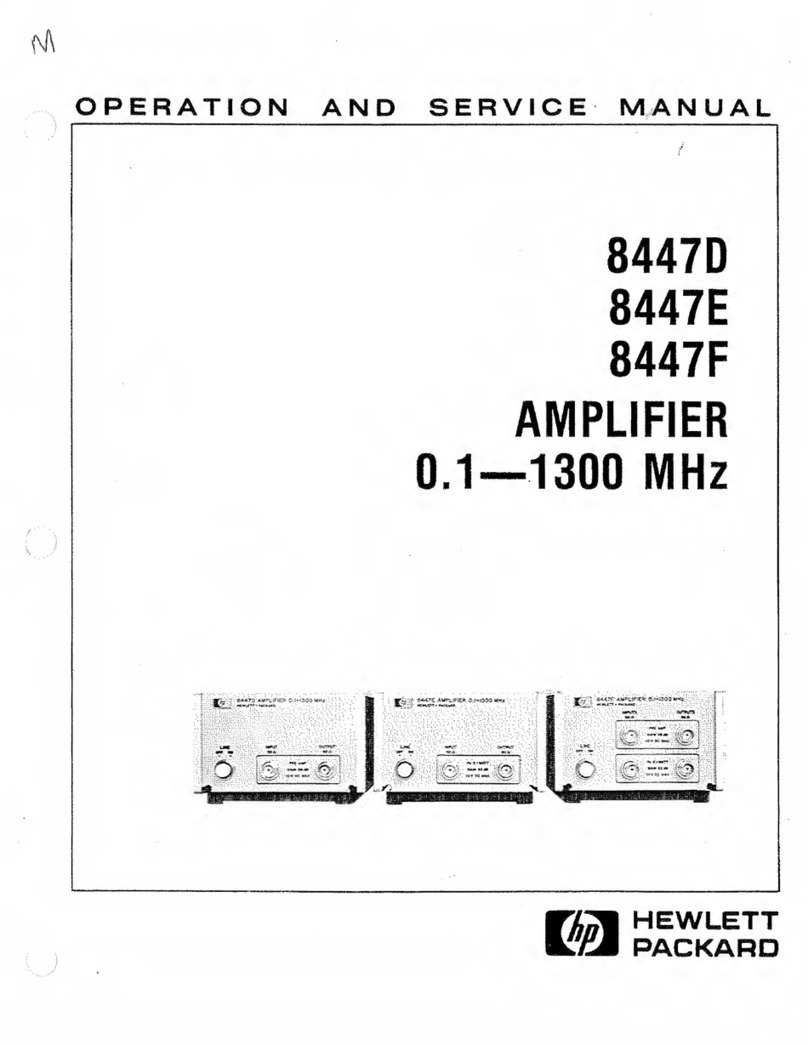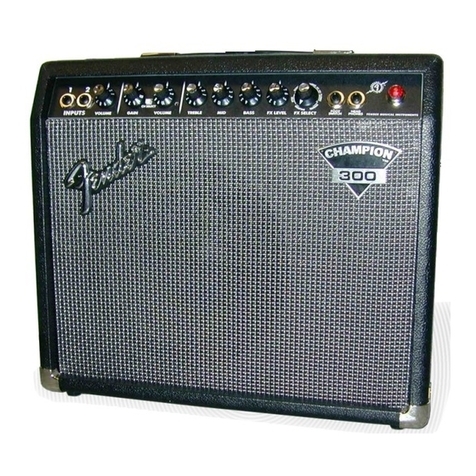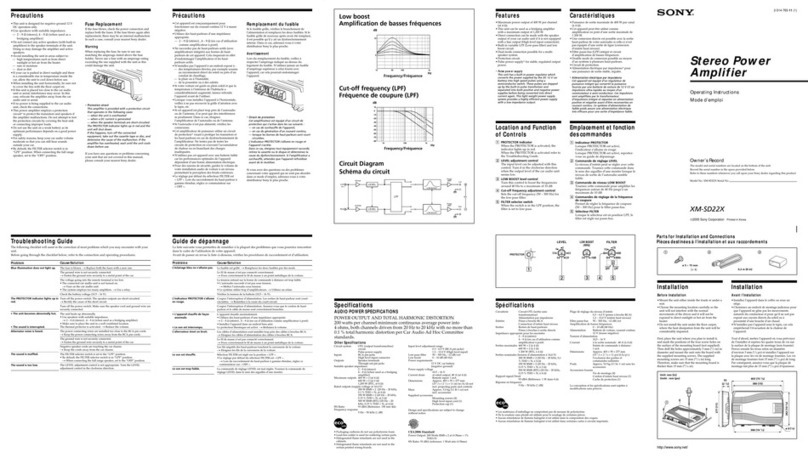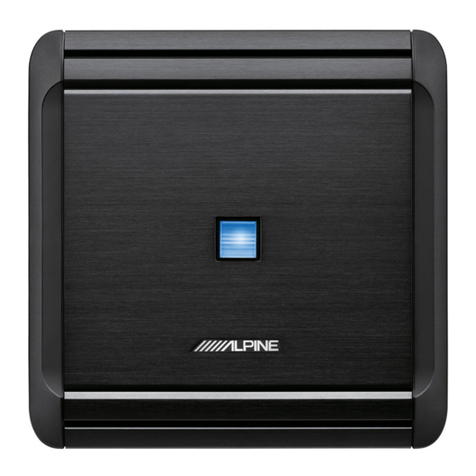Intellijel Quad VCA User manual

Quad VCA Manual v1.00
Quad VCA
Quad Voltage Controlled Amplifier and Cascaded Mixer

QuadVCAManualv1.00
TableofContents
Table of Contents
Overview
Features
Installation
Before Your Start
Installing Your Module
Front Panel
Controls
Inputs and Outputs
Instructions
4 Independent VCAs
Level Bias
Cascaded CV
Cascaded Mixing
Technical Specifications
Page 1

QuadVCAManualv1.00
Overview
The Intellijel Quad VCA is a versatile four channel variable response VCA. It features cascaded
CV inputs and cascaded mix outputs allowing it to be used in a number of versatile
configurations. A boost switch provides additional amplification for low level signals or a subtle
overdrive for audio. More than just simply four VCAs, the Quad VCA is bound to be useful in
any patch.
Features
●Manual LEVEL control per VCA which is convenient when using the module as a mixer
or for biasing when CV modulating the VCA with a bipolar LFO.
●Dedicated CV attenuators with dual color LEDs for monitoring bipolar CV signals.
●Continuously adjustable response from linear to exponential per VCA.
●Each CV input is normalled to the adjacent one for cascaded control.
●Each output is normalled to the mix input of the adjacent one which allows you to use
adjacent sets as submixes or the fourth output can be used as a master mix output when
none of the other outputs are patched.
●Each VCA has a BOOST switch that increases the output level by approximately +6dB
(double).
Page 2

QuadVCAManualv1.00
Installation
Intellijel Eurorack modules are designed to be used with a Eurorack-compatible case and power
supply.
BeforeYourStart
Before installing a new module in your case you must ensure your case’s power supply has
sufficient available capacity to power the module:
● Sum up the specified +12V current draw for all modules, including the new one. Do the
same for the -12 V and +5V current draw. The current draw will be specified in the
manufacturer's technical specifications for each module.
● Compare each of the sums to specifications for your case’s power supply.
● Only proceed with installation if none of the values exceeds the power supply’s
specifications. Otherwise you must remove modules to free up capacity or upgrade your
power supply.
You will also need to ensure you have enough free space (hp) as well as free power headers in
your case to fit the new module.
You can use a tool like ModularGrid to assist in your planning. Failure to adequately power your
modules may result in damage to your modules or power supply. If you are unsure, please
contact us before proceeding.
InstallingYourModule
When installing or removing a module from your case always turn off the power to the case and
disconnect the power cable. Failure to do so may result in serious injury or equipment damage.
Ensure the 10-pin connector on the power cable is connected correctly to the module before
proceeding. The red stripe on the cable must line up with the -12V pins on the module’s power
connector. The pins are indicated with the label -12V, a white stripe next to the connector, the
words “red stripe”, or some combination of those indicators.
Page 3

QuadVCAManualv1.00
Most modules will come with the cable already connected but it is good to double check the
orientation. Be aware that some modules may have headers that serve other purposes so
ensure the cable is connected to the right one.
The other end of the cable, with a 16-pin connector, connects to the power bus board of your
Eurorack case. Ensure the red stripe on the cable lines up with the -12V pins on the bus board.
On Intellijel power supplies the pins are labelled with the label “-12V” and a thick white stripe:
If you are using another manufacturer’s power supply, check their documentation for
instructions.
Page 4

QuadVCAManualv1.00
Once connected, the cabling between the module and power supply should resemble the
picture below:
Before reconnecting power and turning on your modular system, double check that the ribbon
cable is fully seated on both ends and that all the pins are correctly aligned. If the pins are
misaligned in any direction or the ribbon is backwards you can cause damage to your module,
power supply, or other modules.
After you have confirmed all the connections, you can reconnect the power cable and turn on
your modular system. You should immediately check that all your modules have powered on
and are functioning correctly. If you notice any anomalies, turn your system off right away and
check your cabling again for mistakes.
Page 5

QuadVCAManualv1.00
FrontPanel
Page 6

QuadVCAManualv1.00
Controls
1. CV Attenuator - Each channel’s
2. CV LED - Each of the four channels has a red/green LED whose intensity shows the
post-attenuator level of the incoming CV signal. It lights green for positive voltages and
red for negative.
3. Linear / Exponential Response - This attenuator controls the response of the channel’s
VCA to the LEVEL knob and CV input. When fully counterclockwise the response of the
channel’s VCA is exponential. When turned fully clockwise the response is linear.
In-between settings provide a variable response between the two extremes.
4. BOOST - When this switch is set to the left position (disabled) the maximum linear gain
of the channel’s VCA when the LEVEL knob is fully clockwise or +5 V is applied to the
CV input is approximately unity (1:1). When set to the right position (enabled) the signal
is boosted by around +6 dB (2:1).
5. LEVEL 1 - Sets the base level, or bias, of the channel’s VCA. When fully clockwise this
approximately equivalent to applying a +5 V voltage at the CV input. In the fully linear
response this results in unity (1:1) gain. The knob level is summed with the channel’s CV
input.
6. LEVEL 2 - Sets the base level of channel 2.
7. LEVEL 3 - Sets the base level of channel 3.
8. LEVEL 4 - Sets the base level of channel 4.
InputsandOutputs
A. CV 1 - The CV input for controlling the level of channel 1. A +5 V input with the channel’s
attenuator fully clockwise, response knob fully linear, and LEVEL control fully
counterclockwise results in approximately unity (1:1) gain.
B. CV 2 - The CV input for controlling the level of channel 2. If nothing is connected to this
jack, the CV is taken from CV 1.
C. CV 3 - The CV input for controlling the level of channel 3. If nothing is connected to this
jack, the CV is taken from CV 2.
D. CV 4 - The CV input for controlling the level of channel 4. If nothing is connected to this
jack, the CV is taken from CV 3.
E. IN 1 - The input to channel 1.
F. IN 2 - The input to channel 2.
G. IN 3 - The input to channel 3.
H. IN 4 - The input to channel 4.
I. OUT 1 - The signal output for channel 1. If nothing is connected to this jack the output is
mixed into OUT 2.
Page 7

QuadVCAManualv1.00
J. OUT 2 - The signal output for channel 2. If nothing is connected to this jack the output is
mixed into OUT 3.
K. OUT 3 - The signal output for channel 3. If nothing is connected to this jack the output is
mixed into OUT 4.
L. OUT 4/MIX - The signal output for channel 4. I the other three OUT jacks are left
unconnected, this jack can function as the output of a 4-channel mix.
Page 8

QuadVCAManualv1.00
Instructions
4IndependentVCAs
The simplest way to use the Quad VCA is to ignore any of the cascading CV and mixing
functionality and just use it as four independent VCAs:
● Connect the output signal from the source to IN 1. The source can be anything, any
oscillator, LFO, envelope, or any other audio or CV generator.
● Connect OUT 1 to the input of the destination.
● Connect a modulating signal to CV 1. The modulating signal can also be anything but is
typically the output of an envelope generator or LFO. Interesting effects can be had
when using audio-rate sources like oscillators.
● Turn LEVEL 1 fully counterclockwise to remove any CV bias.
● Adjust the CV input attenuator and Linear / Exponential Response control to taste.
You can repeat the above instructions for channels 2, 3, and 4 to get four totally separate VCAs.
LevelBias
The LEVEL control of each channel can be used bias the channel’s response. In this way you
can set the “default” amount of signal passing through the VCA, and then adjust it using external
CV. One situation where this is useful is when controlling amounts of modulation. For example
when the output of one oscillator is being connected to the FM input of another the Quad VCA
can be used to vary the FM amount:
● Connect the sine output of oscillator 1 (the modulator) to IN 1 of the Quad VCA.
● Connect OUT 1 of the Quad VCA to the FM input of oscillator 2 (the carrier).
● Use LEVEL 1 to set the FM amount (index).
● Connect an envelope to CV 1 and adjust the attenuator. The envelope can now be used
to vary the FM index during each note played.
CascadedCV
The Quad VCA features cascading CV, meaning that one CV input can be used to control more
than one channel. If a channel’s CV input is left unconnected then the channel will respond to
CV from the previous channel, subject to its own CV attenuation level:
Page 9

QuadVCAManualv1.00
● Connect two different oscillator outputs or other sound sources to IN 1 and IN 2.
● Connect a CV source such as an envelope to CV 1.
● Take output from OUT 2, or also OUT 1 if going for further parallel processing.
● Use the CV attenuators and linear / exponential response knobs to fine tune the
response of each channel to the incoming CV.
This technique can be extended to up to four channels.
CascadedMixing
The outputs of the Quad VCA have a cascaded mixing feature, allowing it to be used as a
mixer:
● Connect up to four sources to IN 1 through IN 4.
● Take the output from the OUT 4/MIX jack.
● LEVEL 1 through LEVEL 4 control the mix levels.
● You do not need to connect anything to CV 1 through CV 4 if you are using the module
as a manually controlled mixer, but they can be used to automate the mix on one or
more channels.
These various methods of using the Quad VCA can be combined. You can use cascaded
mixing on channels 1-3 by taking the mix out of OUT 3 and then use channel 4 as an
independent VCA, and many other combinations. This is why the Quad VCA is more versatile
than your average VCA!
Page 10

QuadVCAManualv1.00
TechnicalSpecifications
Width
12 hp
Maximum Depth
29 mm
Current Draw
65 mA @ +12 V
65 mA @ -12 V
Page 11
Other manuals for Quad VCA
1
Table of contents
Other Intellijel Amplifier manuals

